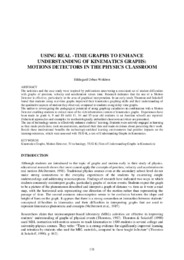Using real -time graphs to enhance understanding of kinematics graphs: motions detectors in the physics classroom
Abstract
The activities and the case study were inspired by publications uncovering a consistent set of student difficulties with graphs of position, velocity and acceleration versus time. Research indicates that the use of a Motion Detector is effective, particularly in the area of graphical interpretation. In an early study Thornton and Sokoloff found that students using real-time graphs improved their kinematics graphing skills and their understanding of the qualitative aspects of motion they observed, compared to students using delay-time graphs.
The author is investigating the pedagogical potential of using graphing calculators in combination with a Motion Detector enabling students to extract most of the rich information content of kinematics graphs. Experiences have been made in grade 6, 9 and 10 (with 11, 14 and 15-year old students in an Austrian school) are reported. Didactical approaches and examples for methodologically embedded classroom activities are presented.
The use of technology seems to effectively enhance students’ learning. Students were actively engaged in learning as they made predictions, took measurements, analyzed their data and made decisions about presenting their work. Beside these motivational benefits the technology-enriched learning environments had positive impacts on the learning outcomes, which were assessed with TUG-K, a test of Understanding Graphs in Kinematics.
